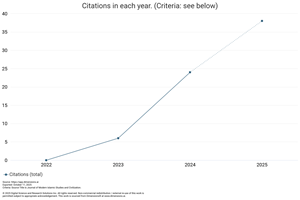Application of PowerPoint Media-Assisted Demonstration Method to Improve Learning Outcomes of Islamic Religious Education at Cirebon Maritim Academy
DOI:
https://doi.org/10.59653/jmisc.v2i03.1049Keywords:
PowerPoint, Learning Outcomes, Islamic Religious EducationAbstract
This study examines the extent to which the application of power point assisted by the demonstration method for Islamic religious subjects at the Cirebon Maritime Academy. This research is based on the problem of the rapid development of the technological era in the era of globalization, of course the world of education will be affected, education now must refer to the pattern of 21st century education which focuses on students to think critically and be able to use information technology. Lecturers must be able to properly apply the PowerPoint-assisted demonstration method to Islamic religious subjects. This research uses descriptive qualitative research. The purpose of this study was to find out how the application of the PowerPoint assisted demonstration method was carried out in the eyes of the Islamic religion at the Cirebon Maritime Academy. This research was conducted with the following procedures: data collection, data compaction, data presentation and drawing conclusions. Data collection techniques by observing, interviewing and documentation. The conclusion from this study is that the application of powerpoint assisted by the demonstration method by lecturers can help the student learning process, so that students can receive good learning in class. The results of this study consist of the application and support of PowerPoint-assisted demonstration methods in Islamic religious subjects. At the implementation stage it is quite good, as evidenced by the presence of lecturers who carry out learning using PowerPoint media, lecturers who actively teach using several teaching methods and lecturers who always lead discussion groups. However, the support stage is not yet perfect because the media and facilities on campus are inadequate, such as limited computers on campus, limited projector equipment in class and the current lack of electrical installations or electrical connectors in class.
Downloads
References
Ahmad Mujin Nasih dan Lilik Nur Kholidah. (2009). Metode dan Tehnik Pembelaaran Agama Islam (p. hal. 49). PT. Refika Aditama.
Aris Shohimin. (2014). 68 Model Pembelajaran Inovatif dalam Kurikulum 2013 (p. hal. 150). Ar-Ruzz Media.
Batubara, B. M. (2021). The problems of the world of education in the middle of the covid-19 pandemic. Budapest International Research and Critics Institute (BIRCI-Journal): Humanities and Social Sciences, 7, 450-457.
Casillas Martín, S., Cabezas Gonzalez, M., & Garcia Penalvo, F. J. (2021). Digital competence of early childhood education teachers: attitude, knowledge and use of ICT. European Journal of Teacher Education, 5, 210-223.
Ely, G. and. (2002). Teaching & Media: A Systematic Approach. Second Edition. Pearson Education.
Fakhrurrazi, F., Wasilah, N., & Jaya, H. (2023). Islam and Knowledge: Harmony between Sciences and Faith. Journal of Modern Islamic Studies and Civilization, 2(01 SE-Articles), 45–57. https://doi.org/10.59653/jmisc.v2i01.416
H.M. Arifin. (1994). Ilmu Pendidikan Islam (p. hal. 41). Bumi Aksara.
Huda, M. (2013). Model-Model Pengajaran dan Pembelajaran, (p. hal. 233). Pustaka Belajar Offset.
Ishmael. (2013). Curriculum 2013: Education Religion Islam and Budi Character (Learning Tool Development Framework). Study team textbook PAI lessons and Character curriculum.
Jones, M. A. (2003). The Use and Abuse of PowerPoint in Teaching and Learning in the Life Sciences: A Personal Overview. dunde.
Khadija. (2014). Motivation study. UIN Press.
Munir. (2012). Multimedia Concepts and Applications in Education. Alfabeth.
Noer, S. (2023). Actualization of Contemporary Islamic Education Concepts: A Study of the Thoughts of Sayyid Naquib Al-Attas and Buya Hamka. Journal of Modern Islamic Studies and Civilization, 2(01), 68–77. https://doi.org/10.59653/jmisc.v2i01.486
Pamuji, S. (2023). Implementation of Academic Supervision through Islamic Religious Education Supervisors in Improving the Performance of Arabic Language Education Teachers at MTs Anwarul Hidayah. Journal of Modern Islamic Studies and Civilization, 2(01), 58–67. https://doi.org/10.59653/jmisc.v2i01.427
Pribudhiana, R., Bin Don, Y., & Bin Yusof, M. R. (2021). (2021). Determining the Influence of Teacher Quality toward Teacher Readiness in Implementing Indonesian Education Policy. Eurasian Journal of Educational Research, 5, 373–390.
Priya, M. M. (2012). Power Point Use in Teaching. Computer Science Departement,.
Ramayulis. (2021). Metodologi Pengajaran Agama Islam (p. hal. 104). Kalam Mulia.
Rochman, A. M. dan C. (2013). Pendekatan Ilmiah Dalam Implementasi Kurikulum (p. ha. 1). PT Remaja Rosdakarya.
Susanto, A. (2013). teori belajar dan pembelajaran di sekolah dasa (pp. 206–206). Kencana Prenada Media.
Downloads
Published
How to Cite
Issue
Section
License
Copyright (c) 2024 Muhammad Muslih

This work is licensed under a Creative Commons Attribution-ShareAlike 4.0 International License.
Authors who publish with this journal agree to the following terms:
- Authors retain copyright and grant the journal right of first publication with the work simultaneously licensed under a Creative Commons Attribution-ShareAlike that allows others to share the work with an acknowledgement of the work's authorship and initial publication in this journal.
- Authors are able to enter into separate, additional contractual arrangements for the non-exclusive distribution of the journal's published version of the work (e.g., post it to an institutional repository or publish it in a book), with an acknowledgement of its initial publication in this journal.
- Authors are permitted and encouraged to post their work online (e.g., in institutional repositories or on their website) prior to and during the submission process, as it can lead to productive exchanges, as well as earlier and greater citation of published work (See The Effect of Open Access).
























